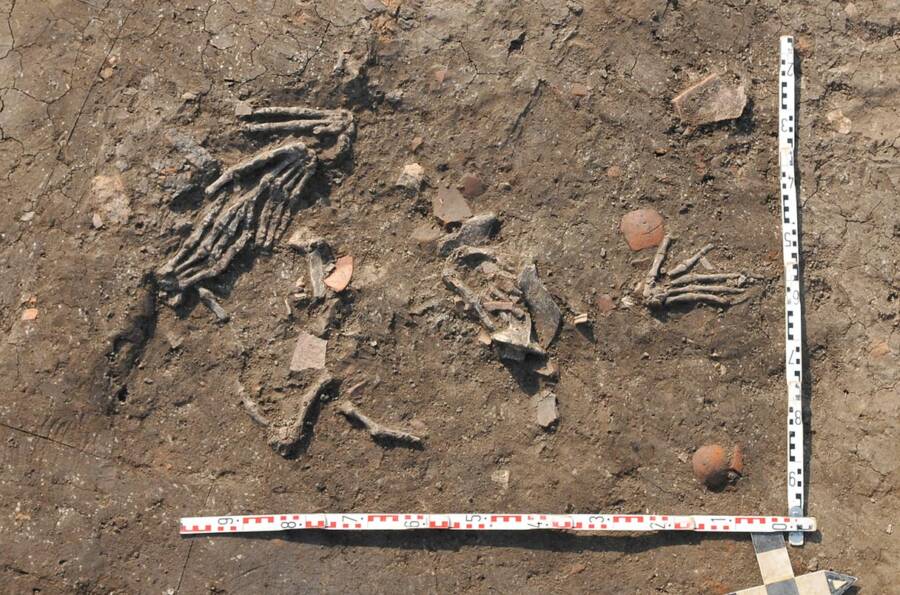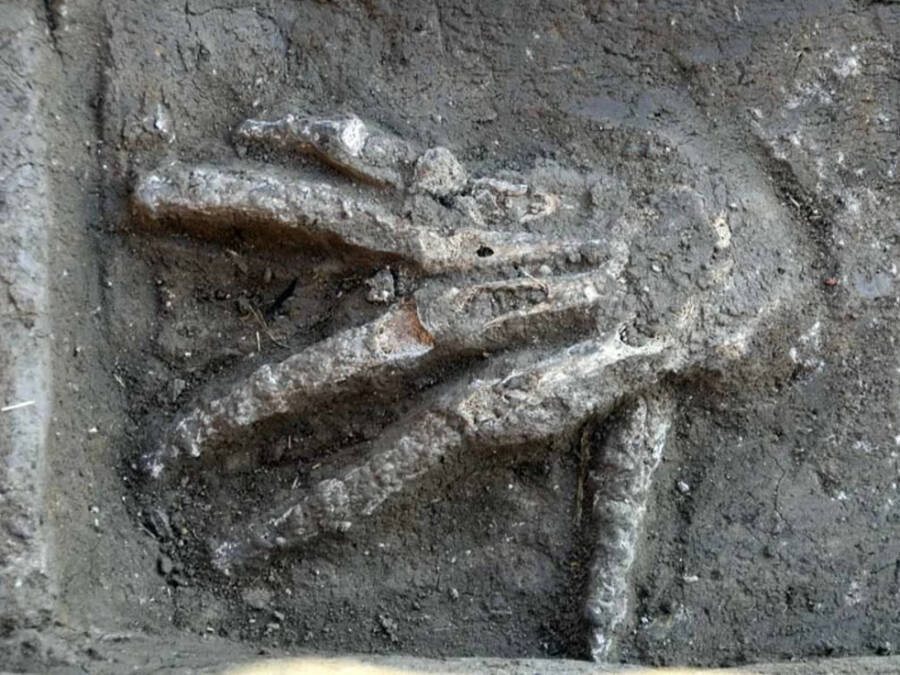The "carefully gathered collection of hands” found in a 3,500-year-old temple may have been exchanged for gold.

DAI / ÖAI under CC-BY-NC-ND 2.0The cache of a dozen hand bones found in the courtyard of an Egyptian palace in 2011.
Archaeologists excavating a northern Egyptian site known as Tell el-Dab’a in 2011 made a shocking and grisly discovery. Beneath the courtyard of an ancient palace, they unearthed a cache of 12 severed, skeletal right hands. Now, over a decade later, researchers may have discovered their purpose.
Per the archaeologists’ study published in Scientific Reports, the hands likely served a ritual purpose — battlefield trophies taken from fallen enemies and exchanged for gold. This trophy-taking custom was known as the “gold of honor” or “gold of valor.”
As researchers noted, the ritual has previously been described in ancient Egyptian texts, but these dozen hands are the first tangible pieces of evidence archaeologists have come across.
“Painstaking work was done on the surgical nature of the amputations,” Kara Cooney, a professor of Egyptian art and architecture at the University of California, Los Angeles, told The New York Times. “Flesh and nails are still attached to the hands, providing more information for a carefully gathered collection of hands.”

Some researchers presented a different theory, however. They suggested that the dismemberment of the hands may have instead been a punishment for criminals. That said, little evidence supports this claim, and certain telltale signs indicate the hands were dismembered for ritualistic reasons.
“They were all prepared properly to look just like a hand should,” study lead Julia Gresky, a paleopathologist with the German Archaeological Institute, told Science.

Gresky et al. A hand discovered at an excavation site in Egypt.
Upon analysis, the hand bones showed no signs of cutmarks, suggesting that the ancient Egyptians were almost surgical in how they removed the hands. They weren’t simply cut off with an ax. Furthermore, Gresky argued that the hands were most likely removed after death, once rigor mortis had passed. Had they been taken prior, it would have been far more difficult to cut them so cleanly.
Furthermore, the hands were modified and later arranged carefully into shallow pits only a few feet from each other. “If it was punishment, the hand would have just been thrown away,” Gresky said. “But they really took care with them and placed them nicely.”
Fingers are also among the first parts of the body to decompose and break away, so finding a cache of still-intact hands is a sign that they were all buried at once, while the flesh was still attached. However, the hands were not preserved well, which made it impossible for researchers to genetically sample them.
Gresky and colleagues employed several noninvasive methods to paint a loose sketch of who the hands may have once belonged to, though. Gresky determined that 11 of the 12 hands belonged to men by comparing the length of the index finger with the length of the ring finger.
“The ring fingers of males tend to be longer than their index fingers,” Gresky said. “The opposite is usually true for females… Those 11 hands were large and robust. The 12th was much smaller and possibly female. I’m quite optimistic that a woman was attached.”
The hands also showed no signs of age-related degeneration, leading researchers to believe they belonged to people between the ages of 14 and 30. Researchers dated the bones to between 1640 and 1530 B.C.E. when a group of people known as the Hyksos ruled.
Once, the site known as Tell el-Dab’a was the ancient Egyptian city of Avaris and briefly served as the Hyksos Egyptian capital. The Hyksos were a dynasty whose name translates to “rulers of foreign countries.” However, the Ptolemaic Egyptian historian Manetho described the Hyksos as “invaders of an obscure race.”
Manetho and other historians wrote that the Hyksos conquered the northern regions of Egypt by force, though recent research shows that the Hyksos were the descendants of peaceful immigrants from southwest Asia. Regardless, the influence of the Hyksos in Egypt can’t be understated.
It is widely believed the Hyksos introduced the horse and chariot, glass-working, and a variety of weapons to the Egyptians, including the battle axe and composite bow. The Hyksos also introduced the gold of honor ritual, which later spread across the rest of Egypt and became common practice.
“The amputations were a safe means to count slain enemies,” said archaeologist and study collaborator Manfred Bietak. “They also made the dead enemy incapable of raising his hand again against Egypt in the Netherworld.”
After reading about the discovery and the ancient tradition behind it, read about the ancient Egyptian child who was found buried with scores of dead dogs. Or, check out these 44 facts about ancient Egypt that separate truth from myth.





